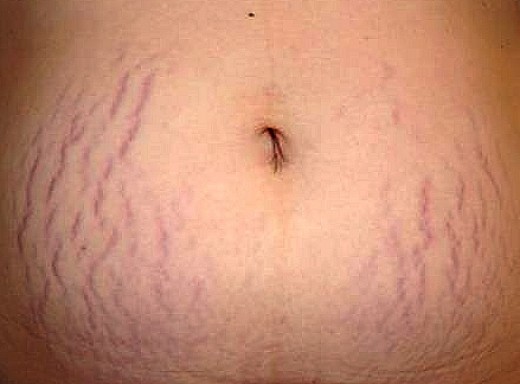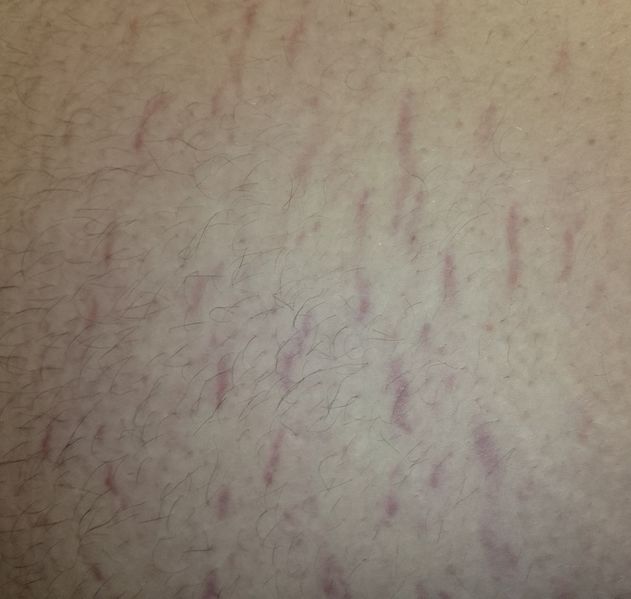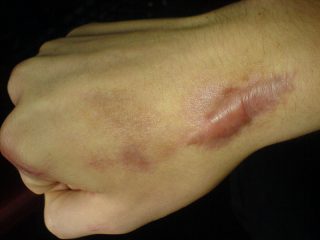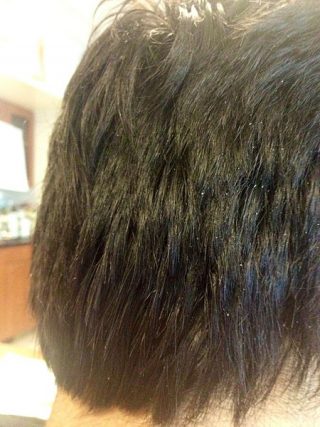Why do stretch marks form?
Stretch marks are visible scars on the skin, the appearance of which is usually caused by hormonal changes in the body that marks the woman’s like – puberty, pregnancy, and menopause. Men can also get such scars – usually, the reasons are related to fast weight changes or bodybuilding. Striae do not pose skincare risks but have a negative impact on our self-esteem.
Stretch marks are scars on the skin caused by rupturing of elastic and collagen fibers in the dermis. They are violet in color in people with whiter skin and more pigmented in those with darker skin, and over time they become pearly white and smooth. These scar formations usually affect the abdomen, hips, chest, and thighs. Stretch marks do not affect all women or men equally but have different effects on each individual.
How do the stretch marks form?
There are usually two main reasons for the formation of stretch marks, which in most cases are related to:
- Sudden stretching of the skin
Rapid changes due to drastic weight gain or pregnancy significantly increase the tension on the skin, which in turn leads to rupture of its collagen fibers. Fibroblasts do not have enough time to produce the required amount of elastin and deal with the enormous stretching so that the elastic fiber network tears in particular areas.
- Hormonal changes
The production of the dermal fibers is influenced by the hormone cortisol, whose excess suppresses the production of collagen and elastin from the fibroblasts. During pregnancy, puberty or other hormonal changes, cortisol is overproduced, which leads to a weakening of the fiber network and reduces its resistance.
Can stretch marks appear when losing/gaining weight?
Yes. Stretch marks after weight gain/loss are a common problem for most people and, practically there are no age limitations. Whether we are talking about a drastic weight reduction or the opposite, such changes have their consequences. Stretch marks can appear shortly after a sudden weight change in both sexes, affecting both younger people and adults.
Can stretch marks tan?
Stretch marks are basically damaged connective tissues in the dermis, where the bottom layers of the tissues were torn apart. These skin areas do not function the way the normal skin does.
While you are tanning, melanin (a dark brown to the black pigment in the skin) is the cause your skin turns brown. However, the color of stretch marks (except for the newly formed) is grayish or whitish and this is because your body did not produce enough melanin to re-pigment the skin.
Therefore, the effect of tanning will be the following:
- The undamaged skin will become darker than your original color
- The stretch marks will remain gray or white and will be even more visible
Can stretch marks become white?
Yes. Overtime (more than a year), stretch marks brighten and become white, gray or acquire a color similar to the skincare skin. White stretch marks are actually old stretch marks. Such scar formations cannot completely heal. Their appearance can significantly improve, yet you should not expect a 100% effect of their fix.
What does a red stretch mark mean?
During the formation of the stretch marks, the skin becomes thinner and pink or purple in color. Soon afterward, pink or purple lines (newly formed stretch marks) appear. Good news is that these stretch marks can completely heal if timely and persistent fix is conducted.
Can stretch marks be purple?
Yes, purple stretch marks are the newly formed ones, which can be successfully treated with various creams, lotions or ointments. In case they are left untreated, they will leave grayish or white-colored scars on the skin.

Do stretch marks itch?
Most people do not experience any discomfort during the formation of stretch marks. Sometimes, however, they can cause a sensation of itching or soreness, which could be quite unpleasant.
Can you get stretch marks during pregnancy?
More than half of pregnant women develop stretch marks during pregnancy. They can distinguish their color according to the natural color of your skin. Most women with thin, light skin develop pink-colored ones, while those with darker shades are barely noticeable and lighter stretch marks.
During pregnancy, stretch marks occur mostly in the hips, thighs, breasts and abdomen. In most cases, over 90% of women have stretch marks on different part of the body as a result of pregnancy.
What helps stretch marks go away?
There are a number of methods for stretch marks removal. If this is really a serious problem for you, consult a beautician before choosing a fix method.
Here are described fix options that are backed up by research and actually have the potential to improve the appearance of stretch marks.
- Tretinoin: In pharmaceutics, there are some studies that indicate that tretinoin (an active ingredient) may have a positive effect on the stretch marks. The typically expected improvement is about 20%, which is not very exciting, but it may be worth the effort and expense for some. Tretinoin cannot be used during pregnancy, and there are contraindications if the future mother intends to breastfeed her baby. (Link to the study)
One study has shown that tretinoin has been able to reduce stretch marks by 14% and their width by 8% after 6 months of fix. Tretinoin also helps restore collagen, making stretch marks look more like “normal” skin.
In fix with products containing tretinoin, it is highly recommended to limit sun exposure as the skin becomes more susceptible to burning. - Laser fix: Studies have been conducted using intense pulsed light and pulsed matrix lasers. The results after five sessions were summarized as having a clinical improvement. After microscopic analysis, improvement in length, depth, and tinting of the stretch marks was demonstrated.
- Peeling: A series of chemical peels can also be helpful in the fix of stretch marks. Trichloroacetic acid peeling (TCA) can improve the appearance of stretch marks when used in an appropriate concentration (typically 20% TCA). It is applied by a beautician or a cosmetic practitioner. Since trichloroacetic acid has the potential to penetrate deeper than some other types of peels, it is believed to have a greater ability to stimulate the production of collagen and elastin, thus restore the damaged tissue.

Are stretch marks dangerous?
Stretch marks do not pose any skincare risks. They usually fade over time and may become barely visible. They are an aesthetic problem, which can have an impact on one’s self-esteem but are not dangerous at all.
Are stretch marks normal?
Absolutely. Stretch marks are a very common skin issue, affecting both teenagers and adults. Anyone can develop stretch marks, although they tend to affect more women than men.










Last update on 2024-04-14 / Affiliate links / Images from Amazon Product Advertising API






